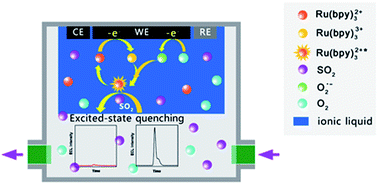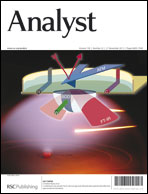An ionic liquid-mediated electrochemiluminescent sensor for the detection of sulfur dioxide at the ppb level†
Abstract
A novel portable SO2 gas sensor based on ionic liquid (IL) mediated electrochemiluminescence (ECL) for detecting SO2 at the ppb levels has been developed. The sensing system for SO2 detection is based on the strong quenching effect of SO2 on the ECL of the tris(2,2′-bipyridine)ruthenium(II) (Ru(bpy)32+)/O2 coreactant system in the IL film. Over the potential window between −1.0 and +1.3 V, O2 can act as an effective coreactant for Ru(bpy)32+ ECL in ILs, giving a bright ECL emission. The ECL of the Ru(bpy)32+/O2 system can be strongly inhibited by SO2 through the direct quenching of the excited state of the luminophore, i.e. Ru(bpy)32+*, by SO2 molecules. The inhibited ECL intensity is proportional to the concentration of SO2 in the range from 40 to 2000 ppb with a detection limit of 20 ppb. The proposed SO2 ECL sensor can be operated at room temperature and shows high selectivity, good reproducibility and long-term stability in a dry atmosphere.


 Please wait while we load your content...
Please wait while we load your content...